一、Netty初识
https://youthlql.gitee.io/javayouth/#/docs/netty/introduction/Netty%E5%85%A5%E9%97%A8-%E7%AC%AC%E4%B8%80%E8%AF%9D?id=java-bio-%e5%ba%94%e7%94%a8%e5%ae%9e%e4%be%8b
- Netty 是一个异步的、基于事件驱动的网络应用框架,用以快速开发高性能、高可靠性的网络 IO 程序。
- Netty 主要针对在 TCP 协议下,面向 Client 端的高并发应用,或者 Peer-to-Peer 场景下的大量数据持续传输的应用。
- 本质是NIO框架。

Netty运用了什么多路复用?

二、IO模型
IO模型:用什么样的通道进行数据的发送和接收,决定着通信性能
1) BIO模型(Blocking IO)
一个线程在accpet()死循环去获取客户端连接,只要产生连接就拿一个线程进行处理。
概念
- 传统阻塞型
- 一个连接就一个线程
- 客户端有连接请求时服务器端就需要启动一个线程进行处理,如果这个连接不做任何事情会造成不必要的线程开销,无法适应高并发!

流程
1.服务器端启动一个 ServerSocket。
2.客户端启动 Socket 对服务器进行通信,默认情况下服务器端需要对每个客户建立一个线程与之通讯。
3.客户端发出请求后,先咨询服务器是否有线程响应,如果没有则会等待,或者被拒绝。
4.如果有响应,客户端线程会等待请求结束后,再继续执行。
代码实现
创建一个maven,创建BIOServer类
package com.atguigu.bio;
import java.io.InputStream;
import java.net.ServerSocket;
import java.net.Socket;
import java.util.concurrent.ExecutorService;
import java.util.concurrent.Executors;
public class BIOServer {
public static void main(String[] args) throws Exception {
//线程池机制
//思路
//1. 创建一个线程池
//2. 如果有客户端连接,就创建一个线程,与之通讯(单独写一个方法)
ExecutorService newCachedThreadPool = Executors.newCachedThreadPool();
//创建ServerSocket
ServerSocket serverSocket = new ServerSocket(6666);
System.out.println("服务器启动了");
while (true) {
System.out.println("线程信息id = " + Thread.currentThread().getId() + "名字 = " + Thread.currentThread().getName());
//监听,等待客户端连接
System.out.println("等待连接....");
//会阻塞在accept()
final Socket socket = serverSocket.accept();
System.out.println("连接到一个客户端");
//就创建一个线程,与之通讯(单独写一个方法)
newCachedThreadPool.execute(new Runnable() {
public void run() {//我们重写
//可以和客户端通讯
handler(socket);
}
});
}
}
//编写一个handler方法,和客户端通讯
public static void handler(Socket socket) {
try {
System.out.println("线程信息id = " + Thread.currentThread().getId() + "名字 = " + Thread.currentThread().getName());
byte[] bytes = new byte[1024];
//通过socket获取输入流
InputStream inputStream = socket.getInputStream();
//循环的读取客户端发送的数据
while (true) {
System.out.println("线程信息id = " + Thread.currentThread().getId() + "名字 = " + Thread.currentThread().getName());
System.out.println("read....");
int read = inputStream.read(bytes);
if (read != -1) {
System.out.println(new String(bytes, 0, read));//输出客户端发送的数据
} else {
break;
}
}
} catch (Exception e) {
e.printStackTrace();
} finally {
System.out.println("关闭和client的连接");
try {
socket.close();
} catch (Exception e) {
e.printStackTrace();
}
}
}
}
客户端通过telnet接通6666接口
在这里插入图片描述

注意两句话:final Socket socket = serverSocket.accept();—没有客户端连接服务器的端口就会一直阻塞在这里。int read = inputStream.read(bytes);—客户端连接了但是没有发消息就会阻塞在这里。

存在的问题
- 每个请求都需要创建独立的线程,与对应的客户端进行数据 Read,业务处理,数据 Write。
- 当并发数较大时,需要创建大量线程来处理连接,系统资源占用较大。
- 连接建立后,如果当前线程暂时没有数据可读,则线程就阻塞在 Read 操作上,造成线程资源浪费。
2)NIO模型(non-blocking IO)
概念
- 同步非阻塞
- 一个线程处理多个请求
- 客户端发送的连接请求都会注册到多路复用器上,多路复用器轮询到有IO请求就处理
- NIO 有三大核心部分:Channel(通道)、Buffer(缓冲区)、Selector(选择器)
- NIO 是面向缓冲区编程的。数据读取到一个它稍后处理的缓冲区,需要时可在缓冲区中前后移动,这就增加了处理过程中的灵活性,使用它可以提供非阻塞式的高伸缩性网络。
- Java NIO 的非阻塞模式,使一个线程从某通道发送请求或者读取数据,但是它仅能得到目前可用的数据,如果目前没有数据可用时,就什么都不会获取,而不是保持线程阻塞,所以直至数据变的可以读取之前,该线程可以继续做其他的事情。非阻塞写也是如此,一个线程请求写入一些数据到某通道,但不需要等待它完全写入,这个线程同时可以去做别的事情。
- 通俗理解:NIO 是可以做到用一个线程来处理多个操作的。假设有 10000 个请求过来,根据实际情况,可以分配 50 或者 100 个线程来处理。不像之前的阻塞 IO 那样,非得分配 10000 个
- HTTP 2.0 使用了多路复用的技术,做到同一个连接并发处理多个请求,而且并发请求的数量比 HTTP 1.1 大了好几个数量级

代码实现
简单说明Buffer
package com.atguigu.nio;
import java.nio.IntBuffer;
public class BasicBuffer {
public static void main(String[] args) {
//举例说明 Buffer 的使用(简单说明)
//创建一个 Buffer,大小为 5,即可以存放 5 个 int
IntBuffer intBuffer = IntBuffer.allocate(5);
//向buffer存放数据
//intBuffer.put(10);
//intBuffer.put(11);
//intBuffer.put(12);
//intBuffer.put(13);
//intBuffer.put(14);
for (int i = 0; i < intBuffer.capacity(); i++) {
intBuffer.put(i * 2);
}
//如何从 buffer 读取数据
//将 buffer 转换,读写切换(!!!)
intBuffer.flip();
while (intBuffer.hasRemaining()) {
System.out.println(intBuffer.get());
}
}
}
NIO vs BIO
| NIO | BIO |
|---|---|
| 块(缓冲区) | 流 |
| 不阻塞 | 阻塞 |
- BIO 基于字节流和字符流进行操作,而 NIO 基于 Channel(通道)和 Buffer(缓冲区)进行操作,数据总是从通道读取到缓冲区中,或者从缓冲区写入到通道中。Selector(选择器)用于监听多个通道的事件(比如:连接请求,数据到达等),因此使用单个线程就可以监听多个客户端通道。
- Buffer和Channel之间的数据流向是双向的( IntBuffer.filp() )
NIO三大核心组件

- 每个 Channel 都会对应一个 Buffer。
- Selector 对应一个线程,一个线程对应多个 Channel(连接)。
- 该图反应了有三个 Channel 注册到该 Selector。
- 程序切换到哪个 Channel 是由事件Event决定的,Event 就是一个重要的概念。
- Selector 会根据不同的事件,在各个通道上切换。
- Buffer 就是一个内存块,底层是有一个数组。
- 数据的读取写入是通过 Buffer,这个和 BIO是不同的,BIO 中要么是输入流,或者是输出流,不能双向,但是 NIO 的 Buffer 是可以读也可以写,需要 flip 方法切换 Channel 是双向的,可以返回底层操作系统的情况,比如 Linux,底层的操作系统通道就是双向的。
缓冲区Buffer
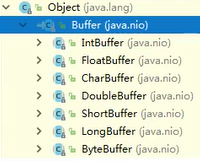

缓冲区本质上是一个可以读写数据的内存块,可以理解成是一个容器对象(数组),该对象提供了一组方法,可以更轻松地使用内存块,缓冲区对象内置了一些机制,能够跟踪和记录缓冲区的状态变化情况。Channel 提供从文件、网络读取数据的渠道,但是读取或写入的数据都必须经由 Buffer。

通道Channel


代码实现——案例一——本地文件写数据


package com.atguigu.nio;
import java.io.FileOutputStream;
import java.nio.ByteBuffer;
import java.nio.channels.FileChannel;
public class NIOFileChannel01 {
public static void main(String[] args) throws Exception {
String str = "hello,尚硅谷";//一个汉字三个字节,一个英文符号1字节
//创建一个输出流 -> channel
FileOutputStream fileOutputStream = new FileOutputStream("d:\\file01.txt");
//通过 fileOutputStream 获取对应的 FileChannel
//这个 fileChannel 真实类型是 FileChannelImpl
FileChannel fileChannel = fileOutputStream.getChannel();
//创建一个缓冲区 ByteBuffer
ByteBuffer byteBuffer = ByteBuffer.allocate(1024);
//将 str 放入 byteBuffer
byteBuffer.put(str.getBytes());
//对 byteBuffer 进行 flip,原来是向里写,现在是往出读!
byteBuffer.flip();
//将 byteBuffer 数据写入到 fileChannel
fileChannel.write(byteBuffer);
fileOutputStream.close();
}
}
代码实现——案例二——本地文件读数据

package com.atguigu.nio;
import java.io.File;
import java.io.FileInputStream;
import java.nio.ByteBuffer;
import java.nio.channels.FileChannel;
public class NIOFileChannel02 {
public static void main(String[] args) throws Exception {
//创建文件的输入流
File file = new File("d:\\file01.txt");
FileInputStream fileInputStream = new FileInputStream(file);
//通过 fileInputStream 获取对应的 FileChannel -> 实际类型 FileChannelImpl
FileChannel fileChannel = fileInputStream.getChannel();
//创建缓冲区
ByteBuffer byteBuffer = ByteBuffer.allocate((int)file.length());
//将通道的数据读入到 Buffer
fileChannel.read(byteBuffer);
//将 byteBuffer 的字节数据转成 String
System.out.println(new String(byteBuffer.array()));
fileInputStream.close();
}
}
输入输出流.getChannel()得到channel;
再创建缓冲区ByteBuffer.allocate(1024);
channel.read/write(缓冲区)
代码实现——案例三——一个缓冲区双向使用(copy)

package com.atguigu.nio;
import java.io.FileInputStream;
import java.io.FileOutputStream;
import java.nio.ByteBuffer;
import java.nio.channels.FileChannel;
public class NIOFileChannel03 {
public static void main(String[] args) throws Exception {
FileInputStream fileInputStream = new FileInputStream("1.txt");
FileChannel fileChannel01 = fileInputStream.getChannel();
FileOutputStream fileOutputStream = new FileOutputStream("2.txt");
FileChannel fileChannel02 = fileOutputStream.getChannel();
ByteBuffer byteBuffer = ByteBuffer.allocate(512);
while (true) { //循环读取
//这里有一个重要的操作,一定不要忘了
/*
public final Buffer clear() {
position = 0;
limit = capacity;
mark = -1;
return this;
}
*/
byteBuffer.clear(); //清空 buffer
int read = fileChannel01.read(byteBuffer);
System.out.println("read = " + read);
if (read == -1) { //表示读完
break;
}
//将 buffer 中的数据写入到 fileChannel02--2.txt
byteBuffer.flip();
fileChannel02.write(byteBuffer);
}
//关闭相关的流
fileInputStream.close();
fileOutputStream.close();
}
}
- 如果没有这句话
byteBuffer.clear(); //清空 buffer就会得到如下结果:无限0
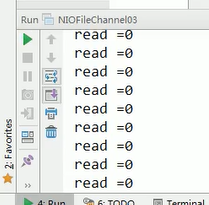
补充read的返回值共三种:

也就是等于零就相当于position==limit,也就是到达了终点位置,无法继续读取了。
注意细节

Selector选择器/多路复用器
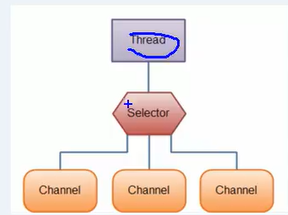


channel首先需注册进selector,然后selector调用select方法就能返回哪个channel有了Event发生,记录其的selectionKey的集合,再通过selectionKey反向得到channel。
其中select方法是阻塞的,至少要有一个监控的channel中发生Event才行!

NIO非阻塞网络编程原理分析图

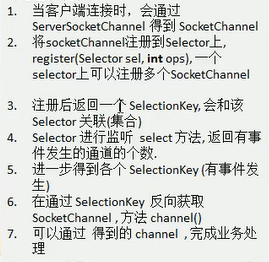
代码实现——案例——NIO完整通信模块
服务器端:
package com.atguigu.nio;
import java.net.InetSocketAddress;
import java.nio.ByteBuffer;
import java.nio.channels.*;
import java.util.Iterator;
import java.util.Set;
public class NIOServer {
public static void main(String[] args) throws Exception{
//创建ServerSocketChannel -> ServerSocket
ServerSocketChannel serverSocketChannel = ServerSocketChannel.open();
//得到一个Selecor对象
Selector selector = Selector.open();
//绑定一个端口6666, 在服务器端监听
serverSocketChannel.socket().bind(new InetSocketAddress(6666));
//设置为非阻塞
serverSocketChannel.configureBlocking(false);
//把 serverSocketChannel 注册到 selector 关心 事件为 OP_ACCEPT pos_1
serverSocketChannel.register(selector, SelectionKey.OP_ACCEPT);
System.out.println("注册后的selectionkey 数量=" + selector.keys().size()); // 1
//循环等待客户端连接
while (true) {
//这里我们等待1秒,如果没有事件发生, 返回
if(selector.select(1000) == 0) { //没有事件发生
System.out.println("服务器等待了1秒,无连接");
continue;
}
//如果返回的>0, 就获取到相关的 selectionKey集合
//1.如果返回的>0, 表示已经获取到关注的事件
//2. selector.selectedKeys() 返回关注事件的集合
// 通过 selectionKeys 反向获取通道
Set<SelectionKey> selectionKeys = selector.selectedKeys();
System.out.println("selectionKeys 数量 = " + selectionKeys.size());
//遍历 Set<SelectionKey>, 使用迭代器遍历
Iterator<SelectionKey> keyIterator = selectionKeys.iterator();
while (keyIterator.hasNext()) {
//获取到SelectionKey
SelectionKey key = keyIterator.next();
//根据key 对应的通道发生的事件做相应处理
if(key.isAcceptable()) { //如果是 OP_ACCEPT, 有新的客户端连接
//该客户端生成一个 SocketChannel
SocketChannel socketChannel = serverSocketChannel.accept();
System.out.println("客户端连接成功 生成了一个 socketChannel " + socketChannel.hashCode());
//将SocketChannel 设置为非阻塞
socketChannel.configureBlocking(false);
//将socketChannel 注册到selector, 关注事件为 OP_READ, 同时给socketChannel
//关联一个Buffer
socketChannel.register(selector, SelectionKey.OP_READ, ByteBuffer.allocate(1024));
System.out.println("客户端连接后 ,注册的selectionkey 数量=" + selector.keys().size()); //2,3,4..
}
if(key.isReadable()) { //发生 OP_READ
//通过key反向获取到对应channel
SocketChannel channel = (SocketChannel)key.channel();
//获取到该channel关联的buffer
ByteBuffer buffer = (ByteBuffer)key.attachment();
channel.read(buffer);
System.out.println("form 客户端 " + new String(buffer.array()));
}
//手动从集合中移动当前的selectionKey, 防止重复操作
keyIterator.remove();
}
}
}
}
客户端:
package com.atguigu.nio;
import java.net.InetSocketAddress;
import java.nio.ByteBuffer;
import java.nio.channels.SocketChannel;
public class NIOClient {
public static void main(String[] args) throws Exception{
//得到一个网络通道
SocketChannel socketChannel = SocketChannel.open();
//设置非阻塞
socketChannel.configureBlocking(false);
//提供服务器端的ip 和 端口
InetSocketAddress inetSocketAddress = new InetSocketAddress("127.0.0.1", 6666);
//连接服务器
if (!socketChannel.connect(inetSocketAddress)) {
while (!socketChannel.finishConnect()) {
System.out.println("因为连接需要时间,客户端不会阻塞,可以做其它工作..");
}
}
//...如果连接成功,就发送数据
String str = "hello, 尚硅谷~";
//Wraps a byte array into a buffer
ByteBuffer buffer = ByteBuffer.wrap(str.getBytes());
//发送数据,将 buffer 数据写入 channel
socketChannel.write(buffer);
System.in.read();
}
}
这ByteBuffer buffer = ByteBuffer.wrap(str.getBytes()); 可以多用用,因为不需要规定Buffer的大小了,直接自动获取str的大小创建Buffer,并且将其放入Buffer,原来是ByteBuffer.put(XXXXXXX)
运行结果:
开启NIOServer.class:

开启一次客户端:

每向selector注册一个channel就会有一个selectionKey。注意:keys是看所有的key(即多少个channel注册进了selector);selectedKeys()是其中哪些发生了Event。

常用方法



write是将buffer放到channel;
read是将channel中放入buffer;
> SocketChannel vs SeverSocketChannel:
服务器必须先建立ServerSocketChannel 来等待客户端的连接
客户端必须建立相对应的SocketChannel来与服务器建立连接
服务器接受到客户端的连接受,再生成一个SocketChannel与此客户端通信
NIO网络编程应用实例—群聊系统

// 服务端:
package com.atguigu.nio.groupchat;
import java.io.IOException;
import java.net.InetSocketAddress;
import java.nio.ByteBuffer;
import java.nio.channels.Channel;
import java.nio.channels.SelectionKey;
import java.nio.channels.Selector;
import java.nio.channels.ServerSocketChannel;
import java.nio.channels.SocketChannel;
import java.util.Iterator;
public class GroupChatServer {
//定义属性
private Selector selector;
private ServerSocketChannel listenChannel;
private static final int PORT = 6667;
//构造器
//初始化工作
public GroupChatServer() {
try {
//得到选择器
selector = Selector.open();
//ServerSocketChannel
listenChannel = ServerSocketChannel.open();
//绑定端口
listenChannel.socket().bind(new InetSocketAddress(PORT));
//设置非阻塞模式
listenChannel.configureBlocking(false);
//将该 listenChannel 注册到 selector
listenChannel.register(selector, SelectionKey.OP_ACCEPT);
} catch (IOException e) {
e.printStackTrace();
}
}
public void listen() {
try {
//循环处理
while (true) {
int count = selector.select();
if (count > 0) { //有事件处理
// 遍历得到 selectionKey 集合
Iterator<SelectionKey> iterator = selector.selectedKeys().iterator();
while (iterator.hasNext()) {
//取出 selectionkey
SelectionKey key = iterator.next();
//监听到 accept
if (key.isAcceptable()) {
SocketChannel sc = listenChannel.accept();
sc.configureBlocking(false);
//将该 sc 注册到 seletor
sc.register(selector, SelectionKey.OP_READ);
//提示
System.out.println(sc.getRemoteAddress() + " 上线 ");
}
if (key.isReadable()) {//通道发送read事件,即通道是可读的状态
// 处理读(专门写方法..)
readData(key);
}
//当前的 key 删除,防止重复处理
iterator.remove();
}
} else {
System.out.println("等待....");
}
}
} catch (Exception e) {
e.printStackTrace();
} finally {
//发生异常处理....
}
}
//读取客户端消息
public void readData(SelectionKey key) {
SocketChannel channel = null;
try {
//得到 channel
channel = (SocketChannel) key.channel();
//创建 buffer
ByteBuffer buffer = ByteBuffer.allocate(1024);
int count = channel.read(buffer);
//根据 count 的值做处理
if (count > 0) {
//把缓存区的数据转成字符串
String msg = new String(buffer.array());
//输出该消息
System.out.println("form客户端:" + msg);
//向其它的客户端转发消息(去掉自己),专门写一个方法来处理
sendInfoToOtherClients(msg, channel);
}
} catch (IOException e) {
try {
System.out.println(channel.getRemoteAddress() + "离线了..");
//取消注册
key.cancel();
//关闭通道
channel.close();
} catch (IOException e2) {
e2.printStackTrace();
}
}
}
//转发消息给其它客户(通道)
private void sendInfoToOtherClients(String msg, SocketChannel self) throws IOException {
System.out.println("服务器转发消息中...");
//遍历所有注册到 selector 上的 SocketChannel,并排除 self
for (SelectionKey key : selector.keys()) {
//通过 key 取出对应的 SocketChannel
Channel targetChannel = key.channel();
//排除自己
if (targetChannel instanceof SocketChannel && targetChannel != self) {
//转型
SocketChannel dest = (SocketChannel) targetChannel;
//将 msg 存储到 buffer
ByteBuffer buffer = ByteBuffer.wrap(msg.getBytes());
//将 buffer 的数据写入通道
dest.write(buffer);
}
}
}
public static void main(String[] args) {
//创建服务器对象
GroupChatServer groupChatServer = new GroupChatServer();
groupChatServer.listen();
}
}
// 客户端:
package com.atguigu.nio.groupchat;
import java.io.IOException;
import java.net.InetSocketAddress;
import java.nio.ByteBuffer;
import java.nio.channels.SelectionKey;
import java.nio.channels.Selector;
import java.nio.channels.SocketChannel;
import java.util.Iterator;
import java.util.Scanner;
public class GroupChatClient {
//定义相关的属性
private final String HOST = "127.0.0.1";//服务器的ip
private final int PORT = 6667;//服务器端口
private Selector selector;
private SocketChannel socketChannel;
private String username;
//构造器,完成初始化工作
public GroupChatClient() throws IOException {
selector = Selector.open();
//连接服务器
socketChannel = SocketChannel.open(new InetSocketAddress(HOST, PORT));
//设置非阻塞
socketChannel.configureBlocking(false);
//将 channel 注册到selector
socketChannel.register(selector, SelectionKey.OP_READ);
//得到 username
username = socketChannel.getLocalAddress().toString().substring(1);
System.out.println(username + " is ok...");
}
//向服务器发送消息
public void sendInfo(String info) {
info = username + " 说:" + info;
try {
socketChannel.write(ByteBuffer.wrap(info.getBytes()));
} catch (IOException e) {
e.printStackTrace();
}
}
//读取从服务器端回复的消息
public void readInfo() {
try {
int readChannels = selector.select();
if (readChannels > 0) {//有可以用的通道
Iterator<SelectionKey> iterator = selector.selectedKeys().iterator();
while (iterator.hasNext()) {
SelectionKey key = iterator.next();
if (key.isReadable()) {
//得到相关的通道
SocketChannel sc = (SocketChannel) key.channel();
//得到一个 Buffer
ByteBuffer buffer = ByteBuffer.allocate(1024);
//读取
sc.read(buffer);
//把读到的缓冲区的数据转成字符串
String msg = new String(buffer.array());
System.out.println(msg.trim());
}
}
iterator.remove(); //删除当前的 selectionKey,防止重复操作
} else {
//System.out.println("没有可以用的通道...");
}
} catch (Exception e) {
e.printStackTrace();
}
}
public static void main(String[] args) throws Exception {
//启动我们客户端
GroupChatClient chatClient = new GroupChatClient();
//启动一个线程,每个 3 秒,读取从服务器发送数据
new Thread() {
public void run() {
while (true) {
chatClient.readInfo();
try {
Thread.currentThread().sleep(3000);
} catch (InterruptedException e) {
e.printStackTrace();
}
}
}
}.start();
//发送数据给服务器端
Scanner scanner = new Scanner(System.in);
while (scanner.hasNextLine()) {
String s = scanner.nextLine();
chatClient.sendInfo(s);
}
}
}
总结:
-
服务器端建立SeverSocketChannel绑定端口和Selector,并将SeverSocketChannel注册进Selector(设置事件为ACCEPT)。Selector是一个Set(每个注册进其中的Channel都带有唯一的一个key)。
-
一旦有客户端连接了,Selector通过select()方法得到SelectedKeys,即发生了对应事件的key也就是某个channel发生了关心的事件,如果是ACCEPT请求就可以通过SeverSocketChannel.accert()获取一个SocketChannel,如果是READ请求就可以通过key.channel()获取对应的SocketChannel。
-
注意客户端与服务器之间通过channel相连,但是channel的双向通信必须经过buffer。
NIO与零拷贝
传统的IO:

copy发生了四次,注意其中的DMA拷贝无法取消掉,所以零拷贝是针对操作系统来说的,即能否降低CPU copy的次数。
方法一:mmap内存映射

将文件映射到内核缓冲区,同时,用户空间可以共享内核空间的数据。这样,在进行网络传输时,就可以减少内核空间到用户空间的拷贝次数
方法二:sendFile
基本原理如下:数据根本不经过用户态,直接从内核缓冲区进入到 SocketBuffer,同时,由于和用户态完全无关,就减少了一次上下文切换


NIO通过transferTo方法实现零拷贝
3)AIO模型

4)三种IO模型
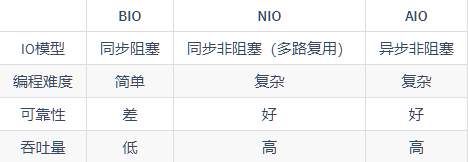

三、Netty使用
1)异步的、事件驱动的网络框架

2)Netty 高性能架构设计
线程模型基本介绍
Netty 主要基于主从 Reactor 多线程模型做了一定的改进,其中主从 Reactor 多线程模型有多个 Reactor。
传统阻塞IO服务模型
- 采用阻塞 IO 模式获取输入的数据
- 每个连接都需要独立的线程完成数据的输入,业务处理,数据返回

问题:
1.当并发数很大,就会创建大量的线程,占用很大系统资源
2.连接创建后,如果当前线程暂时没有数据可读,该线程会阻塞在 Handler对象中的read 操作,导致上面的处理线程资源浪费
Reactor模式
针对以上传统模型的2个缺点,这样解决。

- 线程池机制:不必再为每个连接创建线程,将连接完成后的业务处理任务分配给线程进行处理,一个线程可以处理多个连接的业务。
- 采用IO复用模型:多个客户端进行连接,先把连接请求给ServiceHandler。多个连接共用一个阻塞对象ServiceHandler。
假设,当C1连接没有数据要处理时,传统的IO模型是将其阻塞在handler,这个线程也不可被其他使用。
但是现在,C1客户端只需要阻塞于ServiceHandler,C1之前的处理线程(传统IO模型)便可以处理其他有数据的连接,不会造成线程资源的浪费。
当C1连接再次有数据时,ServiceHandler根据线程池的空闲状态,将请求分发给空闲的线程来处理C1连接的任务。
Reactor 模式,通过一个或多个输入同时传递给服务处理器(ServiceHandler)的模式(基于事件驱动)
服务器端程序处理传入的多个请求,并将它们分派到相应的处理线程,因此 Reactor 模式也叫 Dispatcher 模式
Reactor 模式使用 IO 复用监听事件,收到事件后,分发给某个线程,这点就是网络服务器高并发处理关键。
Reactor组成

Reactor:银行门口的叫号机。
Handler:服务窗口。
单Reactor单线程

优点:
1.模型简单,没有多线程、进程通信、竞争的问题,全部都在一个线程中完成
劣势:
1.性能问题,只有一个线程,无法完全发挥多核 CPU 的性能。Handler在处理某个连接上的业务时,整个进程无法处理其他连接事件,很容易导致性能瓶颈
2.可靠性问题,线程意外终止,或者进入死循环,会导致整个系统通信模块不可用,不能接收和处理外部消息,造成节点故
单Reactor多线程



主从 Reactor 多线程
针对单 Reactor 多线程模型中,Reactor 在单线程中运行,高并发场景下容易成为性能瓶颈,可以让 Reactor 在多线程中运行

主线程Reactor:只管ACCEPT的工作
子线程Reactor:分别管其他工作
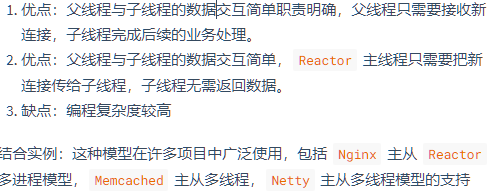
三种Reactor模式记忆

3)Netty模型


4)Netty的依赖导入
pom.xml
<dependencies>
<dependency>
<groupId>io.netty</groupId>
<artifactId>netty-all</artifactId>
<version>4.1.18.Final</version>
</dependency>
</dependencies>
5)Netty模型再说明

6)Netty异步模型
概念

Future说明

异步原理

Future-Listener机制


7)基于Netty的HTTP服务

TestSever:
package com.atguigu.netty.http;
import io.netty.bootstrap.ServerBootstrap;
import io.netty.channel.ChannelFuture;
import io.netty.channel.EventLoopGroup;
import io.netty.channel.nio.NioEventLoopGroup;
import io.netty.channel.socket.nio.NioServerSocketChannel;
public class TestServer {
public static void main(String[] args) throws Exception {
//创建两个group
EventLoopGroup bossGroup = new NioEventLoopGroup(1);
EventLoopGroup workerGroup = new NioEventLoopGroup();
try {
//服务器端初始化设置
ServerBootstrap serverBootstrap = new ServerBootstrap();
serverBootstrap.group(bossGroup, workerGroup)//配置两个group
.channel(NioServerSocketChannel.class)//服务器端的channel
.childHandler(new TestServerInitializer());//自定义workerGroup的Handler
//监听6668端口,返回future
ChannelFuture channelFuture = serverBootstrap.bind(6668).sync();
//监听channel关闭信息
channelFuture.channel().closeFuture().sync();
}finally {
bossGroup.shutdownGracefully();
workerGroup.shutdownGracefully();
}
}
}
TestServerInitializer:
package com.atguigu.netty.http;
import io.netty.channel.ChannelInitializer;
import io.netty.channel.ChannelPipeline;
import io.netty.channel.socket.SocketChannel;
import io.netty.handler.codec.http.HttpServerCodec;
public class TestServerInitializer extends ChannelInitializer<SocketChannel> {
@Override
protected void initChannel(SocketChannel ch) throws Exception {
//向管道加入处理器
//得到管道
ChannelPipeline pipeline = ch.pipeline();
//加入一个netty 提供的httpServerCodec codec =>[coder - decoder]
//HttpServerCodec 说明
//1. HttpServerCodec 是netty 提供的处理http的 编-解码器
pipeline.addLast("MyHttpServerCodec",new HttpServerCodec());
//2. 增加一个自定义的handler
pipeline.addLast("MyTestHttpServerHandler", new TestHttpServerHandler());
System.out.println("ok~~~~");
}
}
TestHttpServerHandler:
package com.atguigu.netty.http;
import io.netty.buffer.ByteBuf;
import io.netty.buffer.Unpooled;
import io.netty.channel.ChannelHandlerContext;
import io.netty.channel.SimpleChannelInboundHandler;
import io.netty.handler.codec.http.*;
import io.netty.util.CharsetUtil;
import java.net.URI;
/*
说明
1. SimpleChannelInboundHandler 是 ChannelInboundHandlerAdapter
2. HttpObject 客户端和服务器端相互通讯的数据被封装成 HttpObject
*/
public class TestHttpServerHandler extends SimpleChannelInboundHandler<HttpObject> {
//channelRead0 读取客户端数据
@Override
protected void channelRead0(ChannelHandlerContext ctx, HttpObject msg) throws Exception {
System.out.println("对应的channel=" + ctx.channel() + " pipeline=" + ctx.pipeline() + " 通过pipeline获取channel" + ctx.pipeline().channel());
System.out.println("当前ctx的handler=" + ctx.handler());
//判断 msg 是不是 httprequest请求
if(msg instanceof HttpRequest) {
System.out.println("ctx 类型="+ctx.getClass());
System.out.println("pipeline hashcode" + ctx.pipeline().hashCode() + " TestHttpServerHandler hash=" + this.hashCode());
System.out.println("msg 类型=" + msg.getClass());
System.out.println("客户端地址" + ctx.channel().remoteAddress());
//获取到
HttpRequest httpRequest = (HttpRequest) msg;
//获取uri, 过滤指定的资源
URI uri = new URI(httpRequest.uri());
//这是请求了网址图标的请求,浏览器自动回启动这个请求的,对于此我们直接略过,保证只有一个请求进入了
if("/favicon.ico".equals(uri.getPath())) {
System.out.println("请求了 favicon.ico, 不做响应");
return;
}
//回复信息给浏览器 [http协议]
ByteBuf content = Unpooled.copiedBuffer("hello, 我是服务器", CharsetUtil.UTF_8);
//构造一个http的相应,即 httpresponse
FullHttpResponse response = new DefaultFullHttpResponse(HttpVersion.HTTP_1_1, HttpResponseStatus.OK, content);
response.headers().set(HttpHeaderNames.CONTENT_TYPE, "text/plain");
response.headers().set(HttpHeaderNames.CONTENT_LENGTH, content.readableBytes());
//将构建好 response返回
ctx.writeAndFlush(response);
}
}
}
运行一次,启动浏览器访问端口:

可以看到每个浏览器的pipeline和Handler是独立的。
如果刷新了浏览器就会生成新的pipeline和Handler
四、Netty核心模块
1)Bootstrap、ServerBootstrap

2)Future、ChannelFuture

3)Channel


4)Selector

5)ChannelHandler 及其实现类






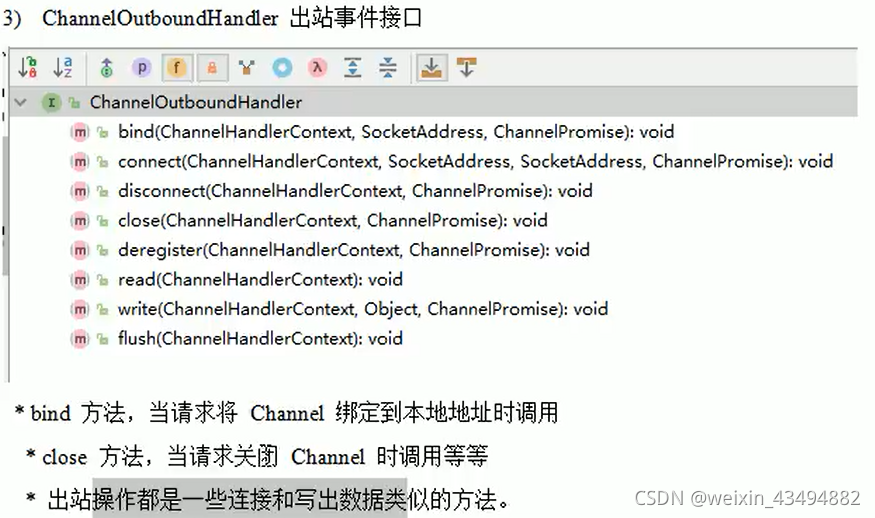
6)Pipeline 和 ChannelPipeline
pipeline双向链表。


入站事件:服务器端->客户端;
出站事件:客户端->服务器端;

7)ChannelHandlerContext


8)ChannelOption

9)EventLoopGroup接口 和其实现类 NioEventLoopGroup




10)Unpooled类
- 专门操作缓冲区的
- 使用:

- 底层维护了下一个读取位置readerIndex+下一个写入位置writerIndex+容量capacity。
- 可写范围 = capacity-writerIndex
可读范围 =writerIndex-readerIndex

故不需要反转,原来NIO中的buffer是利用flip()进行读写反转的。
五、Netty 应用实例-群聊系统

1)服务器端
GroupChatServer
public class GroupChatServer {
private int port; //监听端口
public GroupChatServer(int port) {
this.port = port;
}
//编写run方法,处理客户端的请求
public void run() throws Exception{
//创建两个线程组
EventLoopGroup bossGroup = new NioEventLoopGroup(1);
EventLoopGroup workerGroup = new NioEventLoopGroup(); //8个NioEventLoop
try {
ServerBootstrap b = new ServerBootstrap();
b.group(bossGroup, workerGroup)
.channel(NioServerSocketChannel.class)
.option(ChannelOption.SO_BACKLOG, 128)
.childOption(ChannelOption.SO_KEEPALIVE, true)
.childHandler(new ChannelInitializer<SocketChannel>() {
@Override
protected void initChannel(SocketChannel ch) throws Exception {
//获取到pipeline
ChannelPipeline pipeline = ch.pipeline();
//向pipeline加入解码器
pipeline.addLast("decoder", new StringDecoder());
//向pipeline加入编码器
pipeline.addLast("encoder", new StringEncoder());
//加入自己的业务处理handler
pipeline.addLast(new GroupChatServerHandler());
}
});
System.out.println("netty 服务器启动");
ChannelFuture channelFuture = b.bind(port).sync();
//监听关闭
channelFuture.channel().closeFuture().sync();
}finally {
bossGroup.shutdownGracefully();
workerGroup.shutdownGracefully();
}
}
public static void main(String[] args) throws Exception {
new GroupChatServer(7000).run();
}
}
GroupChatServerHandler
public class GroupChatServerHandler extends SimpleChannelInboundHandler<String> {
//这样写还要自己遍历Channel
//public static List<Channel> channels = new ArrayList<Channel>();
//使用一个hashmap 管理私聊(私聊本案例并未实现,只是提供个思路)
//public static Map<String, Channel> channels = new HashMap<String,Channel>();
//定义一个channle 组,管理所有的channel
//GlobalEventExecutor.INSTANCE) 是全局的事件执行器,是一个单例
private static ChannelGroup channelGroup = new DefaultChannelGroup(GlobalEventExecutor.INSTANCE);
SimpleDateFormat sdf = new SimpleDateFormat("yyyy-MM-dd HH:mm:ss");
//handlerAdded 表示连接建立,一旦连接,第一个被执行
//将当前channel 加入到 channelGroup
@Override
public void handlerAdded(ChannelHandlerContext ctx) throws Exception {
Channel channel = ctx.channel();
//将该客户加入聊天的信息推送给其它在线的客户端
//该方法会将 channelGroup 中所有的channel 遍历,并发送消息,我们不需要自己遍历
channelGroup.writeAndFlush("[客户端]" + channel.remoteAddress() + " 加入聊天" + sdf.format(new java.util.Date()) + " \n");
channelGroup.add(channel);
//私聊如何实现
// channels.put("userid100",channel);
}
//断开连接, 将xx客户离开信息推送给当前在线的客户
@Override
public void handlerRemoved(ChannelHandlerContext ctx) throws Exception {
Channel channel = ctx.channel();
channelGroup.writeAndFlush("[客户端]" + channel.remoteAddress() + " 离开了\n");
System.out.println("channelGroup size" + channelGroup.size());
}
//表示channel 处于活动状态, 提示 xx上线
@Override
public void channelActive(ChannelHandlerContext ctx) throws Exception {
//这个是给服务端看的,客户端上面已经提示xxx加入群聊了
System.out.println(ctx.channel().remoteAddress() + " 上线了~");
}
//表示channel 处于不活动状态, 提示 xx离线了
@Override
public void channelInactive(ChannelHandlerContext ctx) throws Exception {
System.out.println(ctx.channel().remoteAddress() + " 离线了~");
}
//读取数据,转发给在线的每一个客户端
@Override
protected void channelRead0(ChannelHandlerContext ctx, String msg) throws Exception {
//获取到当前channel
Channel channel = ctx.channel();
//这时我们遍历channelGroup, 根据不同的情况,回送不同的消息
channelGroup.forEach(ch -> {
if(channel != ch) { //不是当前的channel,转发消息
ch.writeAndFlush("[客户]" + channel.remoteAddress() + " 发送了消息" + msg + "\n");
}else {//回显自己发送的消息给自己
ch.writeAndFlush("[自己]发送了消息" + msg + "\n");
}
});
}
@Override
public void exceptionCaught(ChannelHandlerContext ctx, Throwable cause) throws Exception {
//关闭通道
ctx.close();
}
}
2)客户端
GroupChatClient
public class GroupChatClient {
//属性
private final String host;
private final int port;
public GroupChatClient(String host, int port) {
this.host = host;
this.port = port;
}
public void run() throws Exception{
EventLoopGroup group = new NioEventLoopGroup();
try {
Bootstrap bootstrap = new Bootstrap()
.group(group)
.channel(NioSocketChannel.class)
.handler(new ChannelInitializer<SocketChannel>() {
@Override
protected void initChannel(SocketChannel ch) throws Exception {
//得到pipeline
ChannelPipeline pipeline = ch.pipeline();
//加入相关handler
pipeline.addLast("decoder", new StringDecoder());
pipeline.addLast("encoder", new StringEncoder());
//加入自定义的handler
pipeline.addLast(new GroupChatClientHandler());
}
});
ChannelFuture channelFuture = bootstrap.connect(host, port).sync();
//得到channel
Channel channel = channelFuture.channel();
System.out.println("-------" + channel.localAddress()+ "--------");
//客户端需要输入信息,创建一个扫描器
Scanner scanner = new Scanner(System.in);
while (scanner.hasNextLine()) {
String msg = scanner.nextLine();
//通过channel 发送到服务器端
channel.writeAndFlush(msg + "\r\n");
}
}finally {
group.shutdownGracefully();
}
}
public static void main(String[] args) throws Exception {
new GroupChatClient("127.0.0.1", 7000).run();
}
}
GroupChatClientHandler
public class GroupChatClientHandler extends SimpleChannelInboundHandler<String> {
//从服务器拿到的数据
@Override
protected void channelRead0(ChannelHandlerContext ctx, String msg) throws Exception {
System.out.println(msg.trim());
}
}

六、Netty心跳检测
https://www.cnblogs.com/duan2/p/8919458.html

IdleStateHandler类
idle——空闲的

- IdleStateHandler 是netty 提供的处理空闲状态的处理器
2. long readerIdleTime : 表示多长时间没有读, 就会发送一个心跳检测包检测是否连接
3. long writerIdleTime : 表示多长时间没有写, 就会发送一个心跳检测包检测是否连接
4. long allIdleTime : 表示多长时间没有读写, 就会发送一个心跳检测包检测是否连接
有些时候,服务器和客户端的连接断开,服务器是可能不知道的,故必须用这种心跳检测包来感知这个连接是否正常!
当IdleStateEvent 触发后 , 就会传递给管道 的下一个handler(自己写一个)去处理,通过调用下一个handler 的 userEventTiggered方法(重写此方法) , 在该方法中去处理 IdleStateEvent (读空闲,写空闲,读写空闲)。
代码实现
MyServer
public class MyServer {
public static void main(String[] args) throws Exception{
//创建两个线程组
EventLoopGroup bossGroup = new NioEventLoopGroup(1);
EventLoopGroup workerGroup = new NioEventLoopGroup(); //8个NioEventLoop
try {
ServerBootstrap serverBootstrap = new ServerBootstrap();
serverBootstrap.group(bossGroup, workerGroup);
serverBootstrap.channel(NioServerSocketChannel.class);
//在bossGroup增加一个日志处理器
serverBootstrap.handler(new LoggingHandler(LogLevel.INFO));
serverBootstrap.childHandler(new ChannelInitializer<SocketChannel>() {
@Override
protected void initChannel(SocketChannel ch) throws Exception {
ChannelPipeline pipeline = ch.pipeline();
//加入一个netty 提供 IdleStateHandler
/*
说明
1. IdleStateHandler 是netty 提供的处理空闲状态的处理器
2. long readerIdleTime : 表示多长时间没有读, 就会发送一个心跳检测包检测是否连接
3. long writerIdleTime : 表示多长时间没有写, 就会发送一个心跳检测包检测是否连接
4. long allIdleTime : 表示多长时间没有读写, 就会发送一个心跳检测包检测是否连接
5. 文档说明
triggers an {@link IdleStateEvent} when a {@link Channel} has not performed
read, write, or both operation for a while.
6. 当 IdleStateEvent 触发后 , 就会传递给管道 的下一个handler去处理,通过调用(触发)
下一个handler 的 userEventTiggered , 在该方法中去处理 IdleStateEvent(读空闲,写空闲,读写空闲)
7.handlerRemoved有时候是无法感知连接断掉,所以还是需要心跳包的检测来判断连接是否还有效
*/
pipeline.addLast(new IdleStateHandler(3,5,7, TimeUnit.SECONDS));
//加入一个对空闲检测进一步处理的handler(自定义)
pipeline.addLast(new MyServerHandler());
}
});
//启动服务器
ChannelFuture channelFuture = serverBootstrap.bind(7000).sync();
channelFuture.channel().closeFuture().sync();
}finally {
bossGroup.shutdownGracefully();
workerGroup.shutdownGracefully();
}
}
}
MyServerHandler
package com.atguigu.netty.heartbeat;
import io.netty.channel.ChannelHandlerContext;
import io.netty.channel.ChannelInboundHandlerAdapter;
import io.netty.handler.timeout.IdleStateEvent;
public class MyServerHandler extends ChannelInboundHandlerAdapter {
/**
*
* @param ctx 上下文
* @param evt 事件
* @throws Exception
*/
@Override
public void userEventTriggered(ChannelHandlerContext ctx, Object evt) throws Exception {
if(evt instanceof IdleStateEvent) {
//将 evt 向下转型 IdleStateEvent
IdleStateEvent event = (IdleStateEvent) evt;
String eventType = null;
switch (event.state()) {
case READER_IDLE:
eventType = "读空闲";
break;
case WRITER_IDLE:
eventType = "写空闲";
break;
case ALL_IDLE:
eventType = "读写空闲";
break;
}
System.out.println(ctx.channel().remoteAddress() + "--超时时间--" + eventType);
System.out.println("服务器做相应处理..");
//如果发生空闲,我们关闭通道
// ctx.channel().close();
}
}
}
七、Google Protobuf(Google Protocol Buffers)
1)编码和解码的基本介绍



要求客户端与服务器端都是java编写,不能跨语言。
2)Protobuf介绍
- 可以适合做RPC(remote procedure call,远程过程调用)的数据交换格式。
- 目前很多公司由http+json=》tcp+Protobuf。


3)Protobuf使用

我们需要编写一个xxx.proto文件,然后通过protoc.exe进行编译,就能得到XX.java,这个直接放进代码中就能使用了。
问题出现:我们不可能对于一个student写一个proto文件,一个teacher写一个文件,不方便,故这样做:
syntax = "proto3";
option optimize_for = SPEED; // 加快解析
option java_package="com.atguigu.netty.codec2"; //指定生成到哪个包下
option java_outer_classname="MyDataInfo"; // 外部类名, 文件名
/*
1.protobuf 可以使用message 管理其他的message。最终决定使用哪一个message作为传输对象
2.假设你某个项目需要传输20个对象,你不可能新建20个proto文件吧。此时你就可以
在一个文件里定义20个message,最后再用一个总的message(比方说这里的MyMessage)
来决定在实际传输时真正需要传输哪一个对象
3.因为你实际传输的时候大部分情况传输的都是一个对象,所以下面用oneof进行了限制
*/
message MyMessage {
//定义一个枚举类型,DataType如果是0则表示一个Student对象实例,DataType这个名称自定义
enum DataType {
StudentType = 0; //在proto3 要求enum的编号从0开始
WorkerType = 1;
}
//用data_type 来标识传的是哪一个枚举类型,这里才真正开始定义MyMessage的数据类型
DataType data_type = 1; //所有后面的数字都只是编号而已
/*
1.oneof关键字 表示每次枚举类型进行传输时,限制最多只能传输一个对象。
dataBody名称也是自定义的
2.为什么这里的序号是2呢?因为上面DataType data_type = 1 占了第一个序号了
3.MyMessage里真正出现的类型只有两个
①DataType类型
②Student类型或者Worker类型(这两个在真正传输的时候只会有一个出现)
*/
oneof dataBody {
Student student = 2; //注意这后面的数字也都只是编号而已
Worker worker = 3;
}
}
message Student {
int32 id = 1;//Student类的属性
string name = 2; //
}
message Worker {
string name=1;
int32 age=2;
}
具体的操作:JavaYouth博客
八、Netty 编解码器和 Handler 调用机制




入站的----服务器到客户端----解码(字节到java);
出站的----客户端到服务器----编码(java到字节);
解码器 - ByteToMessageDecoder



手撕解码器案例
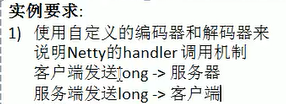

客户端向服务器发送消息
服务器端一个pipeline是个双向链表:
此时对于服务器是接收信息(入站),入站——双向链表——从头到尾执行;
客户端一个pipeline是个双向链表:
此时对于客户端是发送信息(出站),出站——双向链表——从尾到头执行;


双向传输
两端的pipeline都存在着:
》入站的解码器
》出站的编码器
》自身的Handler
该按什么顺序放进pipeline呢 ?
答:无需考虑顺序问题,每边的解码器和编码器都无所谓顺序,只要这两个放在自身的Handler之前即可!


MyServer
package com.atguigu.netty.inboundhandlerandoutboundhandler;
import io.netty.bootstrap.ServerBootstrap;
import io.netty.channel.ChannelFuture;
import io.netty.channel.EventLoopGroup;
import io.netty.channel.nio.NioEventLoopGroup;
import io.netty.channel.socket.nio.NioServerSocketChannel;
public class MyServer {
public static void main(String[] args) throws Exception{
EventLoopGroup bossGroup = new NioEventLoopGroup(1);
EventLoopGroup workerGroup = new NioEventLoopGroup();
try {
ServerBootstrap serverBootstrap = new ServerBootstrap();
serverBootstrap.group(bossGroup,workerGroup).channel(NioServerSocketChannel.class).childHandler(new MyServerInitializer()); //自定义一个初始化类
ChannelFuture channelFuture = serverBootstrap.bind(7000).sync();
channelFuture.channel().closeFuture().sync();
}finally {
bossGroup.shutdownGracefully();
workerGroup.shutdownGracefully();
}
}
}
MyServerInitializer
package com.atguigu.netty.inboundhandlerandoutboundhandler;
import io.netty.channel.ChannelInitializer;
import io.netty.channel.ChannelPipeline;
import io.netty.channel.socket.SocketChannel;
public class MyServerInitializer extends ChannelInitializer<SocketChannel> {
@Override
protected void initChannel(SocketChannel ch) throws Exception {
ChannelPipeline pipeline = ch.pipeline();//一会下断点
//入站的handler进行解码 MyByteToLongDecoder
pipeline.addLast(new MyByteToLongDecoder());
//出站的handler进行编码
pipeline.addLast(new MyLongToByteEncoder());
//自定义的handler 处理业务逻辑
pipeline.addLast(new MyServerHandler());
System.out.println("xx");
}
}
MyServerHandler
package com.atguigu.netty.inboundhandlerandoutboundhandler;
import io.netty.channel.ChannelHandlerContext;
import io.netty.channel.SimpleChannelInboundHandler;
public class MyServerHandler extends SimpleChannelInboundHandler<Long> {
@Override
protected void channelRead0(ChannelHandlerContext ctx, Long msg) throws Exception {
System.out.println("从客户端" + ctx.channel().remoteAddress() + " 读取到long " + msg);
//给客户端发送一个long
ctx.writeAndFlush(98765L);
}
@Override
public void exceptionCaught(ChannelHandlerContext ctx, Throwable cause) throws Exception {
cause.printStackTrace();
ctx.close();
}
}
MyClient
package com.atguigu.netty.inboundhandlerandoutboundhandler;
import io.netty.bootstrap.Bootstrap;
import io.netty.channel.ChannelFuture;
import io.netty.channel.EventLoopGroup;
import io.netty.channel.nio.NioEventLoopGroup;
import io.netty.channel.socket.nio.NioSocketChannel;
public class MyClient {
public static void main(String[] args) throws Exception{
EventLoopGroup group = new NioEventLoopGroup();
try {
Bootstrap bootstrap = new Bootstrap();
bootstrap.group(group).channel(NioSocketChannel.class)
.handler(new MyClientInitializer()); //自定义一个初始化类
ChannelFuture channelFuture = bootstrap.connect("localhost", 7000).sync();
channelFuture.channel().closeFuture().sync();
}finally {
group.shutdownGracefully();
}
}
}
MyClientInitializer
package com.atguigu.netty.inboundhandlerandoutboundhandler;
import io.netty.channel.ChannelInitializer;
import io.netty.channel.ChannelPipeline;
import io.netty.channel.socket.SocketChannel;
public class MyClientInitializer extends ChannelInitializer<SocketChannel> {
@Override
protected void initChannel(SocketChannel ch) throws Exception {
ChannelPipeline pipeline = ch.pipeline();
//加入一个出站的handler 对数据进行一个编码
pipeline.addLast(new MyLongToByteEncoder());
//这时一个入站的解码器(入站handler )
pipeline.addLast(new MyByteToLongDecoder());
//加入一个自定义的handler , 处理业务
pipeline.addLast(new MyClientHandler());
}
}
MyClientHandler
package com.atguigu.netty.inboundhandlerandoutboundhandler;
import io.netty.buffer.Unpooled;
import io.netty.channel.ChannelHandlerContext;
import io.netty.channel.SimpleChannelInboundHandler;
import io.netty.util.CharsetUtil;
import java.nio.charset.Charset;
public class MyClientHandler extends SimpleChannelInboundHandler<Long> {
@Override
protected void channelRead0(ChannelHandlerContext ctx, Long msg) throws Exception {
System.out.println("服务器的ip=" + ctx.channel().remoteAddress());
System.out.println("收到服务器消息=" + msg);
}
//重写channelActive 发送数据
@Override
public void channelActive(ChannelHandlerContext ctx) throws Exception {
System.out.println("MyClientHandler 发送数据");
//ctx.writeAndFlush(Unpooled.copiedBuffer(""))
ctx.writeAndFlush(123456L); //发送的是一个long
}
}
MyByteToLongDecoder
package com.atguigu.netty.inboundhandlerandoutboundhandler;
import io.netty.buffer.ByteBuf;
import io.netty.channel.ChannelHandlerContext;
import io.netty.handler.codec.ByteToMessageDecoder;
import java.util.List;
public class MyByteToLongDecoder extends ByteToMessageDecoder {
/**
*
* decode 会根据接收的数据,被调用多次, 直到确定没有新的元素被添加到list
* , 或者是ByteBuf 没有更多的可读字节为止
* 如果list out 不为空,就会将list的内容传递给下一个 channelinboundhandler处理,
* 该处理器的方法也会被调用多次
*
* @param ctx 上下文对象
* @param in 入站的 ByteBuf
* @param out List 集合,将解码后的数据传给下一个handler
* @throws Exception
*/
@Override
protected void decode(ChannelHandlerContext ctx, ByteBuf in, List<Object> out) throws Exception {
System.out.println("MyByteToLongDecoder 被调用");
//因为 long 8个字节, 需要判断有8个字节,才能读取一个long
if(in.readableBytes() >= 8) {
out.add(in.readLong());
}
}
}
MyLongToByteEncoder
package com.atguigu.netty.inboundhandlerandoutboundhandler;
import io.netty.buffer.ByteBuf;
import io.netty.channel.ChannelHandlerContext;
import io.netty.handler.codec.MessageToByteEncoder;
public class MyLongToByteEncoder extends MessageToByteEncoder<Long> {
//编码方法
@Override
protected void encode(ChannelHandlerContext ctx, Long msg, ByteBuf out) throws Exception {
System.out.println("MyLongToByteEncoder encode 被调用");
System.out.println("msg=" + msg);
out.writeLong(msg);
}
}
出站入站
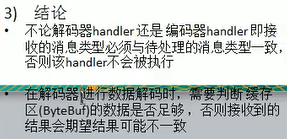
Netty自带解码器
public abstract class ReplayingDecoder extends ByteToMessageDecoder
public class MyByteToLongDecoder2 extends ReplayingDecoder<Void> {
@Override
protected void decode(ChannelHandlerContext ctx, ByteBuf in, List<Object> out) throws Exception {
System.out.println("MyByteToLongDecoder2 被调用");
//在 ReplayingDecoder 不需要判断数据是否足够读取,内部会进行处理判断
out.add(in.readLong());
}
}

九、Netty整合Log4j
<dependency>
<groupId>log4j</groupId>
<artifactId>log4j</artifactId>
<version>1.2.17</version>
</dependency>
<dependency>
<groupId>org.slf4j</groupId>
<artifactId>slf4j-api</artifactId>
<version>1.7.25</version>
</dependency>
<dependency>
<groupId>org.slf4j</groupId>
<artifactId>slf4j-log4j12</artifactId>
<version>1.7.25</version>
<scope>test</scope>
</dependency>
<dependency>
<groupId>org.slf4j</groupId>
<artifactId>slf4j-simple</artifactId>
<version>1.7.25</version>
<scope>test</scope>
</dependency>
配置resources/log4j.properties:
log4j.rootLogger=DEBUG,stdout
log4j.appender.stdout=org.apache.log4j.ConsoleAppender
log4j.appender.stdout.layout=org.apache.log4j.PatternLayout
log4j.appender.stdout.layout.ConversionPattern=[%p]%C{1}-%m%n
能够在运行的时候直接看到相关的信息:

十、TCP的粘包和拆包
1)TCP 粘包和拆包基本介绍



2)举例
public class MyServer {
public static void main(String[] args) throws Exception{
EventLoopGroup bossGroup = new NioEventLoopGroup(1);
EventLoopGroup workerGroup = new NioEventLoopGroup();
try {
ServerBootstrap serverBootstrap = new ServerBootstrap();
serverBootstrap.group(bossGroup,workerGroup).channel(NioServerSocketChannel.class).childHandler(new MyServerInitializer()); //自定义一个初始化类
ChannelFuture channelFuture = serverBootstrap.bind(7000).sync();
channelFuture.channel().closeFuture().sync();
}finally {
bossGroup.shutdownGracefully();
workerGroup.shutdownGracefully();
}
}
}
public class MyServerInitializer extends ChannelInitializer<SocketChannel> {
@Override
protected void initChannel(SocketChannel ch) throws Exception {
ChannelPipeline pipeline = ch.pipeline();
pipeline.addLast(new MyServerHandler());
}
}
public class MyServerHandler extends SimpleChannelInboundHandler<ByteBuf>{
private int count;
@Override
public void exceptionCaught(ChannelHandlerContext ctx, Throwable cause) throws Exception {
//cause.printStackTrace();
ctx.close();
}
@Override
protected void channelRead0(ChannelHandlerContext ctx, ByteBuf msg) throws Exception {
byte[] buffer = new byte[msg.readableBytes()];
msg.readBytes(buffer);
//将buffer转成字符串
String message = new String(buffer, Charset.forName("utf-8"));
System.out.println("服务器接收到数据 " + message);
System.out.println("服务器接收到消息数=" + (++this.count));
//服务器回送数据给客户端, 回送一个随机id ,
ByteBuf responseByteBuf = Unpooled.copiedBuffer(UUID.randomUUID().toString() + " ", Charset.forName("utf-8"));
ctx.writeAndFlush(responseByteBuf);
}
}
public class MyClient {
public static void main(String[] args) throws Exception{
EventLoopGroup group = new NioEventLoopGroup();
try {
Bootstrap bootstrap = new Bootstrap();
bootstrap.group(group).channel(NioSocketChannel.class)
.handler(new MyClientInitializer()); //自定义一个初始化类
ChannelFuture channelFuture = bootstrap.connect("localhost", 7000).sync();
channelFuture.channel().closeFuture().sync();
}finally {
group.shutdownGracefully();
}
}
}
public class MyClientInitializer extends ChannelInitializer<SocketChannel> {
@Override
protected void initChannel(SocketChannel ch) throws Exception {
ChannelPipeline pipeline = ch.pipeline();
pipeline.addLast(new MyClientHandler());
}
}
public class MyClientHandler extends SimpleChannelInboundHandler<ByteBuf> {
private int count;
@Override
public void channelActive(ChannelHandlerContext ctx) throws Exception {
//使用客户端发送10条数据 hello,server 编号
for(int i= 0; i< 10; ++i) {
ByteBuf buffer = Unpooled.copiedBuffer("hello,server " + i, Charset.forName("utf-8"));
ctx.writeAndFlush(buffer);
}
}
@Override
protected void channelRead0(ChannelHandlerContext ctx, ByteBuf msg) throws Exception {
byte[] buffer = new byte[msg.readableBytes()];
msg.readBytes(buffer);
String message = new String(buffer, Charset.forName("utf-8"));
System.out.println("客户端接收到消息=" + message);
System.out.println("客户端接收消息数量=" + (++this.count));
}
@Override
public void exceptionCaught(ChannelHandlerContext ctx, Throwable cause) throws Exception {
cause.printStackTrace();
ctx.close();
}
}
运行一次客户端:

再运行一次客户端

3)解决方案
自定义协议+编解码器
主要解决的是服务器的每次读取长度的问题
自定义协议:
//协议包类——协议包对象
public class MessageProtocol {
private int len; //关键
private byte[] content;
public int getLen() {
return len;
}
public void setLen(int len) {
this.len = len;
}
public byte[] getContent() {
return content;
}
public void setContent(byte[] content) {
this.content = content;
}
}
MyServer:
public class MyServer {
public static void main(String[] args) throws Exception{
EventLoopGroup bossGroup = new NioEventLoopGroup(1);
EventLoopGroup workerGroup = new NioEventLoopGroup();
try {
ServerBootstrap serverBootstrap = new ServerBootstrap();
serverBootstrap.group(bossGroup,workerGroup).channel(NioServerSocketChannel.class).childHandler(new MyServerInitializer()); //自定义一个初始化类
ChannelFuture channelFuture = serverBootstrap.bind(7000).sync();
channelFuture.channel().closeFuture().sync();
}finally {
bossGroup.shutdownGracefully();
workerGroup.shutdownGracefully();
}
}
}
MyServerInitializer
public class MyServerInitializer extends ChannelInitializer<SocketChannel> {
@Override
protected void initChannel(SocketChannel ch) throws Exception {
ChannelPipeline pipeline = ch.pipeline();
pipeline.addLast(new MyMessageDecoder());//解码器
pipeline.addLast(new MyMessageEncoder());//编码器
pipeline.addLast(new MyServerHandler());
}
}
MyServerHandler
//处理业务的handler
public class MyServerHandler extends SimpleChannelInboundHandler<MessageProtocol>{
private int count;
@Override
public void exceptionCaught(ChannelHandlerContext ctx, Throwable cause) throws Exception {
//cause.printStackTrace();
ctx.close();
}
@Override
protected void channelRead0(ChannelHandlerContext ctx, MessageProtocol msg) throws Exception {
//接收到数据,并处理
int len = msg.getLen();
byte[] content = msg.getContent();
System.out.println("服务器接收到信息如下");
System.out.println("长度=" + len);
System.out.println("内容=" + new String(content, Charset.forName("utf-8")));
System.out.println("服务器接收到消息包数量=" + (++this.count));
//服务器接收信息后,回复消息
System.out.println("服务端开始回复消息------");
String responseContent = UUID.randomUUID().toString();
int responseLen = responseContent.getBytes("utf-8").length;
byte[] responseContent2 = responseContent.getBytes("utf-8");
//构建一个协议包
MessageProtocol messageProtocol = new MessageProtocol();
messageProtocol.setLen(responseLen);
messageProtocol.setContent(responseContent2);
ctx.writeAndFlush(messageProtocol);
}
}
MyClient
public class MyClient {
public static void main(String[] args) throws Exception{
EventLoopGroup group = new NioEventLoopGroup();
try {
Bootstrap bootstrap = new Bootstrap();
bootstrap.group(group).channel(NioSocketChannel.class)
.handler(new MyClientInitializer()); //自定义一个初始化类
ChannelFuture channelFuture = bootstrap.connect("localhost", 7000).sync();
channelFuture.channel().closeFuture().sync();
}finally {
group.shutdownGracefully();
}
}
}
public class MyClientInitializer extends ChannelInitializer<SocketChannel> {
@Override
protected void initChannel(SocketChannel ch) throws Exception {
ChannelPipeline pipeline = ch.pipeline();
pipeline.addLast(new MyMessageEncoder()); //加入编码器
pipeline.addLast(new MyMessageDecoder()); //加入解码器
pipeline.addLast(new MyClientHandler());
}
}
MyClientHandler
public class MyClientHandler extends SimpleChannelInboundHandler<MessageProtocol> {
private int count;
@Override
public void channelActive(ChannelHandlerContext ctx) throws Exception {
//使用客户端发送10条数据 "今天天气冷,吃火锅" 编号
for(int i = 0; i< 5; i++) {
String mes = "今天天气冷,吃火锅";
byte[] content = mes.getBytes(Charset.forName("utf-8"));
int length = mes.getBytes(Charset.forName("utf-8")).length;
//创建协议包对象
MessageProtocol messageProtocol = new MessageProtocol();
messageProtocol.setLen(length);
messageProtocol.setContent(content);
ctx.writeAndFlush(messageProtocol);
}
}
// @Override
protected void channelRead0(ChannelHandlerContext ctx, MessageProtocol msg) throws Exception {
int len = msg.getLen();
byte[] content = msg.getContent();
System.out.println("客户端接收到消息如下");
System.out.println("长度=" + len);
System.out.println("内容=" + new String(content, Charset.forName("utf-8")));
System.out.println("客户端接收消息数量=" + (++this.count));
}
@Override
public void exceptionCaught(ChannelHandlerContext ctx, Throwable cause) throws Exception {
System.out.println("异常消息=" + cause.getMessage());
ctx.close();
}
}
MyMessageDecoder
public class MyMessageDecoder extends ReplayingDecoder<Void> {
@Override
protected void decode(ChannelHandlerContext ctx, ByteBuf in, List<Object> out) throws Exception {
System.out.println();
System.out.println();
System.out.println("MyMessageDecoder decode 被调用");
//需要将得到二进制字节码-> MessageProtocol 数据包(对象)
int length = in.readInt();
byte[] content = new byte[length];
in.readBytes(content);
//封装成 MessageProtocol 对象,放入 out, 传递下一个handler业务处理
MessageProtocol messageProtocol = new MessageProtocol();
messageProtocol.setLen(length);
messageProtocol.setContent(content);
//放入out传给下一个hanlder进行处理
out.add(messageProtocol);
}
}
MyMessageEncoder
public class MyMessageEncoder extends MessageToByteEncoder<MessageProtocol> {
@Override
protected void encode(ChannelHandlerContext ctx, MessageProtocol msg, ByteBuf out) throws Exception {
System.out.println("MyMessageEncoder encode 方法被调用");
out.writeInt(msg.getLen());
out.writeBytes(msg.getContent());
}
}
4)结果
可以看到



无论运行几次,Server都是分5次接收的,这样就解决了TCP粘包问题。
十一、RPC远程过程调用

1)远程过程调用
两个或多个应用程序都分布在不同的服务器上,它们之间的调用都像是本地方法调用一样。

A调用远程的B的api,就像调用自己的方法一样。
2)基于Netty实现dubbo RPC
需求:

设计:


代码:基于Netty实现的dubbo RPC
封装的RPC
NettyServer
public class NettyServer {
//外部暴露方法,利用此方法调用
public static void startServer(String hostName, int port) {
startServer0(hostName,port);
}
//编写一个方法,完成对NettyServer的初始化和启动
private static void startServer0(String hostname, int port) {
//创建两个NioEventLoopGroup,一个处理连接,一个处理读写
EventLoopGroup bossGroup = new NioEventLoopGroup(1);
EventLoopGroup workerGroup = new NioEventLoopGroup();
try {
//创建服务器初始化设置
ServerBootstrap serverBootstrap = new ServerBootstrap();
//正常的服务器设置套路
serverBootstrap.group(bossGroup,workerGroup)
.channel(NioServerSocketChannel.class)
.childHandler(new ChannelInitializer<SocketChannel>() {
@Override
protected void initChannel(SocketChannel ch) throws Exception {
ChannelPipeline pipeline = ch.pipeline();
pipeline.addLast(new StringDecoder());
pipeline.addLast(new StringEncoder());
pipeline.addLast(new NettyServerHandler()); //添加了自己的业务处理器
}
}
);
//将此服务器设置绑定在(主机,端口),sync是异步处理
ChannelFuture channelFuture = serverBootstrap.bind(hostname, port).sync();
System.out.println("服务提供方开始提供服务~~");
channelFuture.channel().closeFuture().sync();
}catch (Exception e) {
e.printStackTrace();
}
finally {
bossGroup.shutdownGracefully();
workerGroup.shutdownGracefully();
}
}
}
NettyServerHandler
//服务器这边handler比较简单
public class NettyServerHandler extends ChannelInboundHandlerAdapter {
//当服务端从channel中读取时触发此方法
@Override
public void channelRead(ChannelHandlerContext ctx, Object msg) throws Exception {
System.out.println("---服务端开始收到来自客户端的消息---");
//获取客户端发送的消息,并调用服务
System.out.println("原始消息:" + msg);
/*
1.客户端在调用服务器的api 时,我们需要定义一个协议,比如我们要求 每次发消息是都
必须以某个字符串开头 "HelloService#hello#你好"
2.Dubbo注册在Zookeeper里时,这种就是类的全路径字符串,你用IDEA的zookeeper插件
就可以清楚地看到
*/
if(msg.toString().startsWith(ClientBootstrap.providerName)) {
String result = new HelloServiceImpl().hello(msg.toString().substring(msg.toString().lastIndexOf("#") + 1));
ctx.writeAndFlush(result);
}
}
@Override
public void exceptionCaught(ChannelHandlerContext ctx, Throwable cause) throws Exception {
ctx.close();
}
}
NettyClientHandler
public class NettyClientHandler extends ChannelInboundHandlerAdapter implements Callable {
private ChannelHandlerContext context;//上下文
private String result; //返回的结果
private String para; //客户端调用方法时,传入的参数
//与服务器的连接创建后,就会被调用, 这个方法是第一个被调用(1)
@Override
public void channelActive(ChannelHandlerContext ctx) throws Exception {
System.out.println(" channelActive 被调用 ");
context = ctx; //因为我们在其它方法会使用到 ctx
}
//(2)
void setPara(String para) {
System.out.println(" setPara ");
this.para = para;
}
//被代理对象调用, 发送数据给服务器,-> wait -> 等待被唤醒(channelRead) -> 返回结果 (3)-》5
@Override
public synchronized Object call() throws Exception {
System.out.println(" call1 被调用 ");
context.writeAndFlush(para);
//进行wait
wait(); //等待channelRead 方法获取到服务器的结果后,唤醒
System.out.println(" call2 被调用 ");
return result; //服务方返回的结果
}
//收到服务器的数据后,调用方法 (4)
//
@Override
public synchronized void channelRead(ChannelHandlerContext ctx, Object msg) throws Exception {
System.out.println(" channelRead 被调用 ");
result = msg.toString();
notify(); //唤醒等待的线程
}
@Override
public void exceptionCaught(ChannelHandlerContext ctx, Throwable cause) throws Exception {
ctx.close();
}
}
NettyClient
public class NettyClient {
//创建线程池
private static ExecutorService executor = Executors.newFixedThreadPool(Runtime.getRuntime().availableProcessors());
private static NettyClientHandler client;
private int count = 0;
//编写方法使用代理模式,获取一个代理对象
public Object getBean(final Class<?> serivceClass, final String providerName) {
//动态代理
return Proxy.newProxyInstance(Thread.currentThread().getContextClassLoader(),
new Class<?>[]{serivceClass}, (proxy, method, args) -> {
System.out.println("(proxy, method, args) 进入...." + (++count) + " 次");
//{} 部分的代码,客户端每调用一次 hello, 就会进入到该代码
if (client == null) {
initClient();
}
//设置要发给服务器端的信息
//providerName:协议头,args[0]:就是客户端要发送给服务端的数据
client.setPara(providerName + args[0]);
//
return executor.submit(client).get();
});
}
//初始化客户端
private static void initClient() {
client = new NettyClientHandler();
//创建EventLoopGroup
NioEventLoopGroup group = new NioEventLoopGroup();
Bootstrap bootstrap = new Bootstrap();
bootstrap.group(group)
.channel(NioSocketChannel.class)
.option(ChannelOption.TCP_NODELAY, true)
.handler(
new ChannelInitializer<SocketChannel>() {
@Override
protected void initChannel(SocketChannel ch) throws Exception {
ChannelPipeline pipeline = ch.pipeline();
pipeline.addLast(new StringDecoder());
pipeline.addLast(new StringEncoder());
pipeline.addLast(client);
}
}
);
try {
bootstrap.connect("127.0.0.1", 7000).sync();
} catch (Exception e) {
e.printStackTrace();
}
}
}
接口
HelloService
//这个是接口,是服务提供方和 服务消费方都需要
public interface HelloService {
String hello(String mes);
}
服务端
HelloServiceImpl
public class HelloServiceImpl implements HelloService{
private static int count = 0;
//当有消费方调用该方法时, 就返回一个结果
@Override
public String hello(String mes) {
System.out.println("收到客户端消息=" + mes);
System.out.println();
//根据mes 返回不同的结果
if(mes != null) {
return "你好客户端, 我已经收到你的消息。消息为:[" + mes + "] ,第" + (++count) + " 次 \n";
} else {
return "你好客户端, 我已经收到你的消息 ";
}
}
}
ServerBootstrap
//ServerBootstrap 会启动一个服务提供者,就是 NettyServer
public class ServerBootstrap {
public static void main(String[] args) {
NettyServer.startServer("127.0.0.1", 7000);
}
}
客户端
public class ClientBootstrap {
//这里定义协议头
public static final String providerName = "HelloService#hello#";
public static void main(String[] args) throws Exception{
//创建一个消费者
NettyClient customer = new NettyClient();
//创建代理对象
HelloService service = (HelloService) customer.getBean(HelloService.class, providerName);
for (;; ) {
Thread.sleep(2 * 1000);
//通过代理对象调用服务提供者的方法(服务)
String res = service.hello("你好 dubbo~");
System.out.println("服务端返回调用的结果 res= " + res);
}
}
}
结果


3)调用过程
- ClientBootstrap.java中的main发起调用
- 运行到

这句话时调用NettyClient.java中的getBean方法,在此方法里与服务端建立链接。 - NettyClientHandler.java中的channelActive方法。
- 接着回到NettyClient.java中的getBean调用NettyClientHandler.java中的setPara,调用完之后再回到NettyClient.java中的getBean,用线程池提交任务。
- 因为用线程池提交了任务,就准备执行NettyClientHandler.java中的call线程任务
- 在NettyClientHandler.java中的call中发送数据给服务提供者
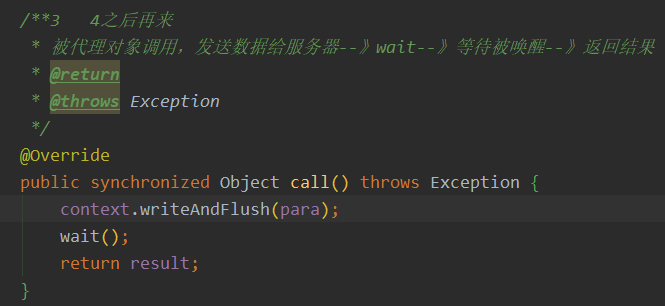
由于还没收到服务提供者的数据结果,所以wait住。 - 从Socket通道中收到了数据,所以执行NettyServerHandler.java中的channelRead,然后因为此方法中执行了。
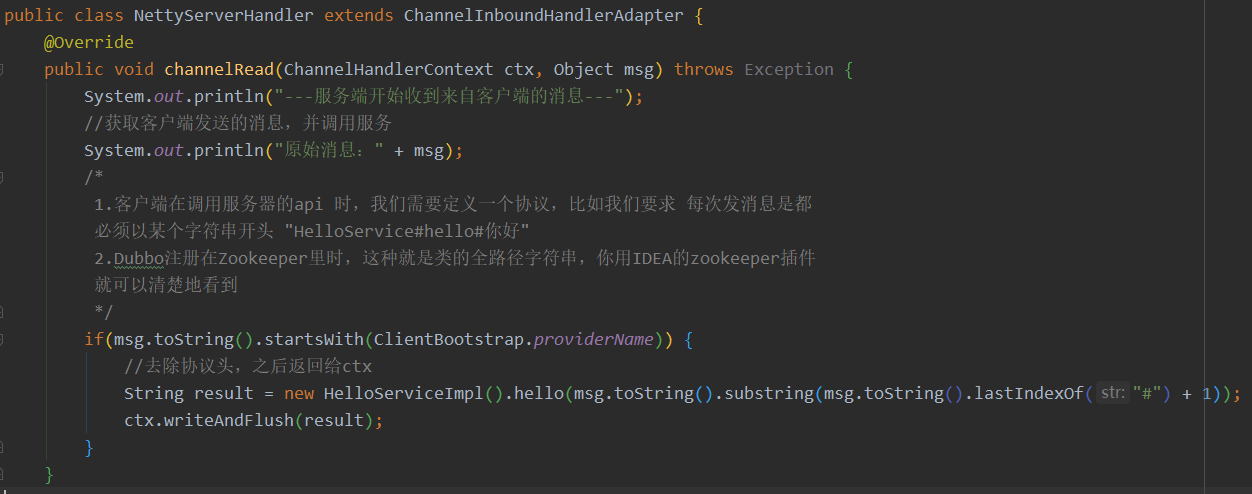
就去HelloServiceImpl.java中的hello中执行业务逻辑,返回数据给NettyServerHandler.java中的channelRead,NettyServerHandler.java中的channelRead再把数据发给客户端(将数据推进channel)。 - 客户端读取channel中的数据,自动调用NettyClientHandler.java中的channelRead收到服务提供者发来的数据,唤醒(notify)之前wait的线程。
- 所以之前wait的线程从NettyClientHandler.java中的call苏醒,返回result给NettyClient.java中的getBean。
- NettyClient.java中的getBean的main中的此函数调用返回,得到服务端提供的数据。

- 一次RPC调用结束。
4)结论
对于客户端来说仅仅使用了一次动态代理生成了代理对象,但是在生成的过程中,由于是RPC,所以我们采用NIO技术,即服务器初始化了处理连接的BossGroup和处理读写的workerGroup,客户端配置了一个处理读写的Group,当我们在使用线程池进行调用时,自动触发call方法,将客户端传输的数据压入channel中,服务端WorkerGroup立即触发channelRead方法,在此方法中进行处理(比如查询内容),将结果压入channel中,立即客户端触发Group的channelRead方法,唤醒了处于wait状态的,将result返回到,这样就创建好了代理对象,直接调用代理对象即可。
整体的好处是能够Nio的优势发挥出来,即在进行远程传参与接收时,服务端与客户端都是几个EventLoop在处理事件,并不会发生阻塞问题,我们看起来就好像没有任何的远程的意思,调用远程的方法就好像在本地调用本地方法一样。






















 187
187











 被折叠的 条评论
为什么被折叠?
被折叠的 条评论
为什么被折叠?








